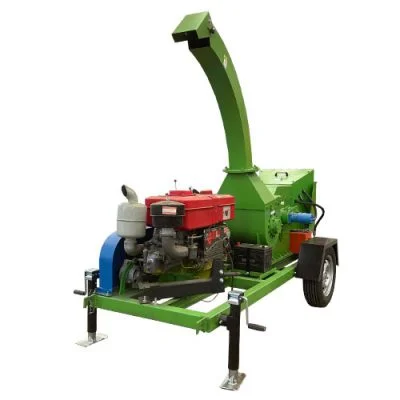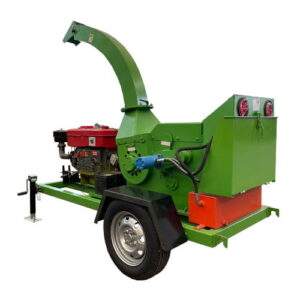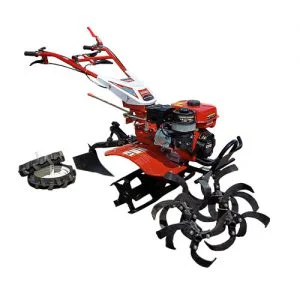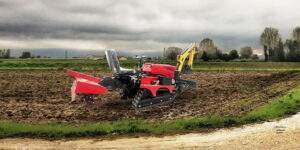Maximize Efficiency with a Professional Wood Chipper
Introduction
In the realm of landscaping, forestry, and arboriculture, the importance of efficiency cannot be overstated. A professional wood chipper is an invaluable tool that significantly enhances productivity by reducing large volumes of wood waste into manageable chips. This blog aims to guide you on how to maximize efficiency with a professional wood chipper, covering essential aspects such as selecting the right model, maintenance, safety practices, and the benefits it brings to your operations.
Understanding Professional Wood Chippers

Before diving into the specifics of maximizing efficiency, it’s crucial to understand what a professional wood chipper is and how it functions. A professional wood chipper is a heavy-duty machine designed to shred branches, leaves, and other types of wood debris into small, usable chips. These chips can be used for mulch, composting, or other landscaping applications.
Key Features of a Professional Wood Chipper
- Powerful Engine: Provides the necessary force to process large volumes of wood.
- Durable Blades: Made from high-strength steel to ensure longevity and effective cutting.
- Variable Feed Rates: Allows for the adjustment of the speed at which wood is fed into the chipper.
- Safety Mechanisms: Includes features like emergency stop buttons and safety shields.
Selecting the Right Professional Wood Chipper
Choosing the right professional wood chipper is the first step towards maximizing efficiency. Several factors should be considered to ensure you select the best model for your needs.
Assess Your Requirements
Evaluate the volume and type of wood debris you typically handle. If you frequently deal with large branches and logs, opt for a chipper with a high horsepower engine and larger chipping capacity.
Consider the Power Source
Professional wood chippers can be powered by gasoline, diesel, or electricity. Gasoline and diesel-powered chippers are more suitable for heavy-duty tasks and outdoor use, while electric chippers are ideal for smaller tasks and indoor use.
Evaluate the Chipping Capacity
The chipping capacity refers to the maximum diameter of wood that the chipper can process. Ensure the chipper you choose can handle the largest diameter of wood debris you encounter.
Portability and Maneuverability
Consider the weight and mobility of the chipper. For larger properties or commercial use, a towable model may be more practical.
Comparison Table of Popular Professional Wood Chippers
| Model | Power Source | Horsepower (HP) | Chipping Capacity (inches) | Weight (lbs) | Key Features |
|---|---|---|---|---|---|
| Varyon hy – 6130 | Diesel | 32 | 4.7 | 1763 | Fast crushing up and down outlet double choice |
| Bandit 150XP | Gasoline | 74 | 12 | 4500 | Dual feed rollers, hydraulic lift cylinder |
| Morbark 12R | Diesel | 83 | 13 | 5200 | Reversing auto-feed, winch-assisted feed table |
| Woodchuck WC-12 | Gasoline | 60 | 12 | 4800 | Hydraulic feed system, large capacity fuel tank |
| Timberwolf TW 230HB | Diesel | 35 | 8 | 2550 | Compact design, easy maintenance access |
Maximizing Efficiency with Your Professional Wood Chipper

Once you’ve selected the right professional wood chipper, the next step is to utilize it efficiently. Here are some tips to help you get the most out of your machine.
Regular Maintenance
Regular maintenance is key to keeping your professional wood chipper in optimal condition. This includes:
Blade Sharpening and Replacement
Sharp blades are crucial for efficient chipping. Inspect the blades regularly and sharpen or replace them as needed.
Engine Maintenance
Ensure the engine is well-maintained by checking the oil levels, replacing the air filter, and inspecting the fuel system.
Lubrication
Regularly lubricate moving parts to prevent wear and tear and ensure smooth operation.
Proper Operation Techniques
Efficient use of a professional wood chipper involves proper operating techniques. This includes:
Feeding Techniques
Feed wood debris into the chipper at a steady rate to prevent clogging. Avoid forcing large branches, as this can damage the machine.
Safety Practices
Always wear appropriate safety gear, such as gloves, goggles, and ear protection. Be aware of your surroundings and keep bystanders at a safe distance.
Optimizing Workflow
Organize your workflow to maximize efficiency. Position the chipper close to the work area to minimize the distance you need to carry debris. Use a staging area to sort and prepare wood before feeding it into the chipper.
Utilizing Chipped Wood
Maximize the value of the chipped wood by using it effectively. Chipped wood can be used as mulch, compost, or biofuel. This not only reduces waste but also adds value to your operations.
Conclusion
A professional wood chipper is a powerful tool that can significantly enhance the efficiency of your landscaping, forestry, or arboriculture operations. By choosing the right model, maintaining it properly, and using it effectively, you can maximize its benefits and improve your productivity. Whether you are dealing with large-scale commercial projects or managing a private property, a professional wood chipper is an investment that pays off in both time and resources.
FAQ
Q: What is the difference between a professional wood chipper and a residential chipper?
A: A professional wood chipper is designed for heavy-duty use, capable of handling larger volumes and diameters of wood debris. It typically has a more powerful engine and more durable construction compared to a residential chipper, which is intended for lighter, occasional use.
Q: How often should I sharpen or replace the blades on my professional wood chipper?
A: The frequency of blade sharpening or replacement depends on the volume and type of wood being processed. Generally, blades should be inspected after every 20-30 hours of use and sharpened or replaced as needed to maintain efficiency.
Q: Can I use a professional wood chipper for both hardwood and softwood?
A: Yes, professional wood chippers are designed to handle a variety of wood types, including both hardwood and softwood. However, it’s important to ensure that the chipper’s blades are sharp and that the machine is well-maintained to handle different wood densities effectively.
Q: What safety precautions should I take when operating a professional wood chipper?
A: Always wear protective gear, including gloves, goggles, and ear protection. Follow the manufacturer’s instructions and safety guidelines, keep bystanders at a safe distance, and never attempt to clear jams or perform maintenance while the chipper is running.
Q: How do I know which chipping capacity is suitable for my needs?
A: Consider the largest diameter of wood debris you typically handle. Choose a chipper with a chipping capacity that can comfortably process this size to ensure efficient operation and prevent damage to the machine.




